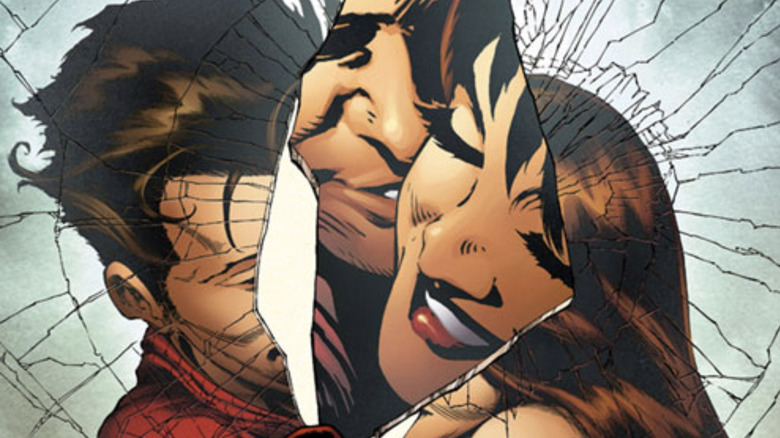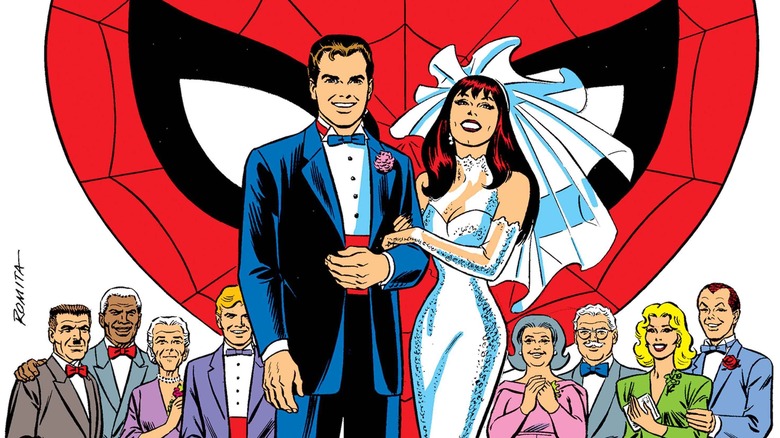Spider-Man: Across The Spider-Verse's Mayday Parker Reminds Us Of A Controversial Marvel Comics Arc
At the end of "Spider-Man: Into The Spider-Verse," Peter B. Parker (Jake Johnson) went back to his home universe and reconciled with his ex Mary Jane Watson. Peter is back in the sequel, "Across The Spider-Verse" and this time he's got someone coming with him — his and MJ's daughter, Mayday Parker, who has inherited her father's spider powers.
Don't expect to see this new Spider-Girl pop up in mainstream Marvel Comics, though. In that world, Peter and MJ are currently separated. They've been on-again, off-again since 2008. What happened that year? Only the most despised Spider-Man storyline ever written, "One More Day." What happens in this infamous story? During "Civil War," Aunt May was shot and is in terminal condition. So, to save her life, Peter and MJ make a deal with Mephisto (the Marvel Universe's devil) to erase their marriage from history. Some extra salt in the wound? During "One More Day," Mephisto intermittently appears as a young girl. This disguise is all but said to be the daughter that Peter and MJ now won't have.
It's a story that's been panned by the whole spectrum of comic readers, from professional critics to simple fanboys. How did such a vile story as "One More Day" even get to print? How could "Across The Spider-Verse" alleviate its sins? Let's dive in.
The making of a disaster
The writer of "Amazing Spider-Man" at the time was J. Michael Straczynski (JMS) — you may know him as the creator of "Babylon 5".
However, JMS was a big believer in Peter & MJ's relationship; he even brought them back together after a previous breakup. Moreover, JMS' run is about Peter growing up. He finds a steady job as a high school science teacher. Aunt May finally discovers her nephew is Spider-Man, so they have an adult conversation about it. "One More Day," a story about sacrificing your future to cling to the past, is anathema to what JMS previously wrote.
The real mastermind was Joe Quesada, then Marvel's editor-in-chief (he also personally drew the last two issues of the arc, #544 to #545, and has a co-writer credit on the latter). Quesada disliked Spider-Man being married, feeling it aged the character. In fairness to Quesada, he's not the only one who feels this way. Roger Stern, who wrote "Amazing Spider-Man" in the 1980s, also feels MJ isn't the right girl for Peter. Even Gerry Conway — the writer who killed Gwen Stacy and made MJ into Peter's love interest — has said he thinks Spider-Man should never leave adolescence.
The problem is how "One More Day" splits Peter and Mary Jane up. Aunt May would never support Peter and Mary Jane sacrificing their own happiness for her or them making a deal with the devil. Peter acquiescing to Mephisto is a betrayal of Spider-Man's ethos, "With great power comes great responsibility." Worst of all — instead of a simple breakup or divorce, the marriage is wiped from history. Quesada didn't grow up with Peter and MJ being married, but the current generation of comic readers in 2008 had. So while for him, this was a reversion to the mean, readers saw a betrayal.
Brand New Day
From JMS' remarks, he didn't agree with the decision to split up Peter and Mary Jane. He did recognize that Spider-Man wasn't his character and that Quesada's authority as editor-in-chief superseded his own. That's why he was willing to write the story. The real sticking point was the execution — there's a reason Joe Quesada has a co-writer credit on the final issue.
The "Amazing Spider-Man" relaunch that followed was called "Brand New Day." There were a lot of changes beyond MJ's new absence. Peter was no longer a teacher, he got his mechanical web shooters back (rather than the organic ones he grew during JMS' one), no-one remembered Spider-Man publicly revealing his identity in "Civil War," and Harry Osborn — dead since 1993 — was somehow alive again.
In a 2008 interview with Comic Book Resources, Quesada elaborated on JMS' plan and gave his side of the story. JMS' explanation for the changes was that, in this new, Mephisto-altered timeline, Harry's drug addiction never spiraled out of control (see "Amazing Spider-Man" #96-98). Ergo, Norman Osborn doesn't have the stress of his son's illness hanging over him, doesn't become the Green Goblin again, and doesn't kill Gwen Stacy. Therefore, Peter and Mary Jane never get together or marry. Quesada felt this erased too much established history, resulting in a vague retcon in the published "One More Day." In an email to Newsarama, JMS aired his frustrations with how "One More Day" turned out, mostly due to the editorial's attitude of "it's magic, we don't have to explain [discrepancies]."
After One More Day
However, JMS maintains his respect for Quesada as an editor. In 2007, he wrote on his message board:
"The only thing I *can* tell you, with absolute certainty, is that what Joe [Quesada] does with Spidey and all the rest of the Marvel characters, he does out of a genuine love of the character. He's not looking to sabotage anything, he's not looking to piss off the fans, he genuinely believes in the rightness of his views not out of a sense of "I'm the boss" but because he loves these characters and the Marvel universe."
Fans haven't been so gracious and "One More Day" remains a stain on Quesada's reputation.
For most of the 2010s, "Amazing Spider-Man" was written by Dan Slott, who stubbornly kept Peter and MJ apart. He was succeeded by Nick Spencer. Surprisingly, the guy who made Captain America say "Hail Hydra" chose to play it safe with Spidey. He didn't erase "One More Day," but he had Peter and MJ get back together at the end of his first issue. Now, though, the current "Amazing Spider-Man" writer is Zeb Wells and MJ is with a new guy named Paul. C'est la vie.
What to read instead?
If you want to read some good Peter and MJ comics before "Across The Spider-Verse" debuts, your current best bet is alternate universe stories. "Spider-Girl" stars a teenage Mayday Parker as a superheroine while her parents grew into middle age together; the series ran for over 100 issues between 1998 and 2010. In 2015, the mini-series "Renew Your Vows" featured an alternate timeline Spider-Family: Peter, MJ, and their daughter Anna-May. The mini-series spun off into an ongoing from 2016 to 2018. These two stories are the probable inspiration for Peter B. and Mayday in "Across The Spider-Verse."
One of my favorite recent Spidey stories is "Spider-Man: Life Story" by Chip Zdarsky and Mark Bagley. This depicts a world where Peter became Spider-Man in 1962 (i.e. when "Amazing Fantasy #15" was published) and aged in real-time. In the 1980s (issue #3), he and MJ have twins, Ben and Claire, together. They later separate, but get back together in the 1990s (issue #4) and stay together until the end. Peter's final thoughts are of the two together: "You're my heart, Mary Jane Watson. You're my jackpot."
The last great canon Peter Parker and Mary Jane story, though, is Matt Fraction and Salvador Larroca's "To Have and To Hold." Published in 2007's "Sensational Spider-Man Annual #1," the story reads like a defiant stand against "One More Day." As the world conspires to pull them apart, Peter and MJ explain how they fell in love and why their relationship endures. The "Spider-Verse" films may depict a multiverse of countless possibilities, but they understand that Peter Parker and Mary Jane Watson are the only ones right for each other.
"Spider-Man: Across the Spider-Verse" arrives in theaters on June 2, 2023.




